The Cambridge History of Japan, Vol. 1: Ancient Japan
Подождите немного. Документ загружается.

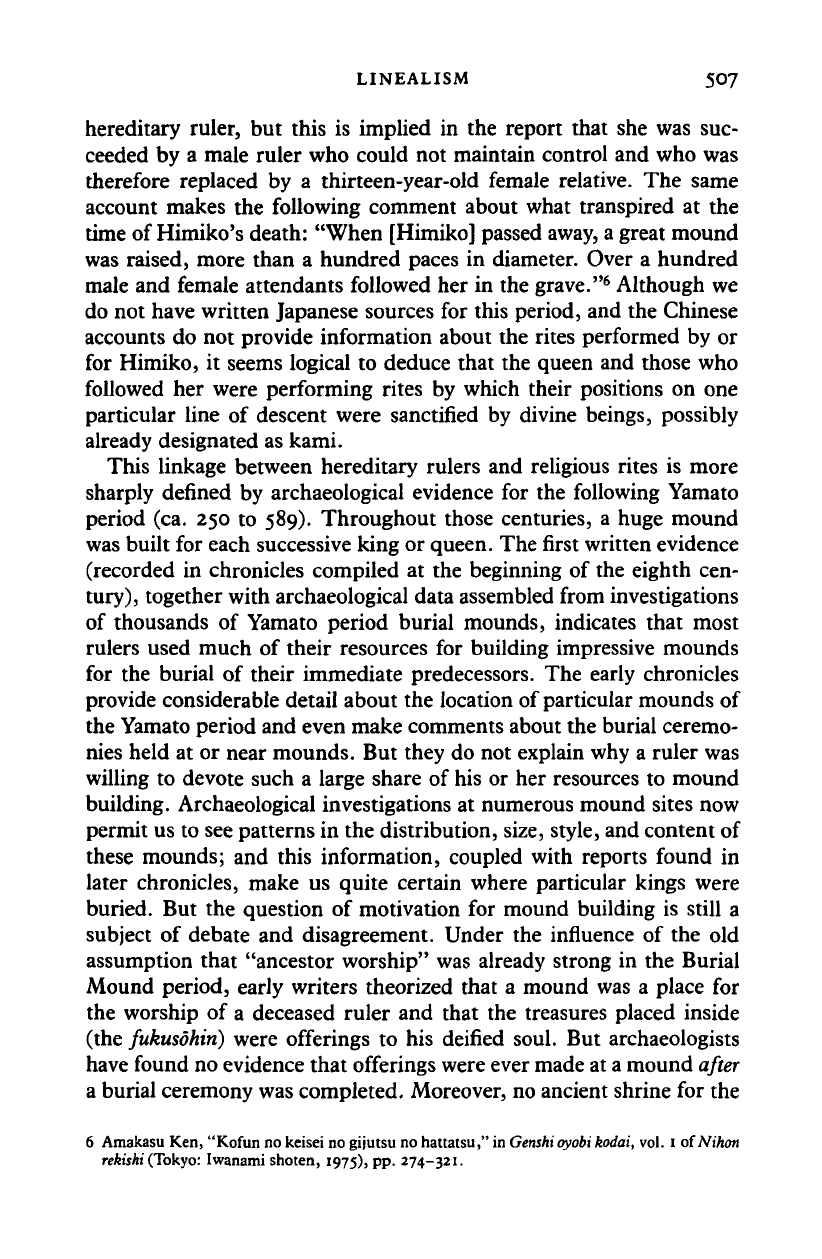
LINEALISM 507
hereditary ruler, but this is implied in the report that she was suc-
ceeded by a male ruler who could not maintain control and who was
therefore replaced by a thirteen-year-old female relative. The same
account makes the following comment about what transpired at the
time of Himiko's death: "When [Himiko] passed away, a great mound
was raised, more than a hundred paces in diameter. Over a hundred
male and female attendants followed her in the grave."
6
Although we
do not have written Japanese sources for this period, and the Chinese
accounts do not provide information about the rites performed by or
for Himiko, it seems logical to deduce that the queen and those who
followed her were performing rites by which their positions on one
particular line of descent were sanctified by divine beings, possibly
already designated as kami.
This linkage between hereditary rulers and religious rites is more
sharply defined by archaeological evidence for the following Yamato
period (ca. 250 to 589). Throughout those centuries, a huge mound
was built for each successive king or queen. The first written evidence
(recorded in chronicles compiled at the beginning of the eighth cen-
tury),
together with archaeological data assembled from investigations
of thousands of Yamato period burial mounds, indicates that most
rulers used much of their resources for building impressive mounds
for the burial of their immediate predecessors. The early chronicles
provide considerable detail about the location of particular mounds of
the Yamato period and even make comments about the burial ceremo-
nies held at or near mounds. But they do not explain why a ruler was
willing to devote such a large share of his or her resources to mound
building. Archaeological investigations at numerous mound sites now
permit us to see patterns in the distribution, size, style, and content of
these mounds; and this information, coupled with reports found in
later chronicles, make us quite certain where particular kings were
buried. But the question of motivation for mound building is still a
subject of debate and disagreement. Under the influence of the old
assumption that "ancestor worship" was already strong in the Burial
Mound period, early writers theorized that a mound was a place for
the worship of a deceased ruler and that the treasures placed inside
(the
fukusohin)
were offerings to his deified soul. But archaeologists
have found no evidence that offerings were ever made at a mound
after
a burial ceremony was completed. Moreover, no ancient shrine for the
6 Amakasu Ken, "Kofun no keisei no gijutsu no hattatsu," in Genshioyobikodai, vol. i oiNihon
rekishi
(Tokyo: Iwanami shoten, 1975), pp. 274-321.
Cambridge Histories Online © Cambridge University Press, 2008
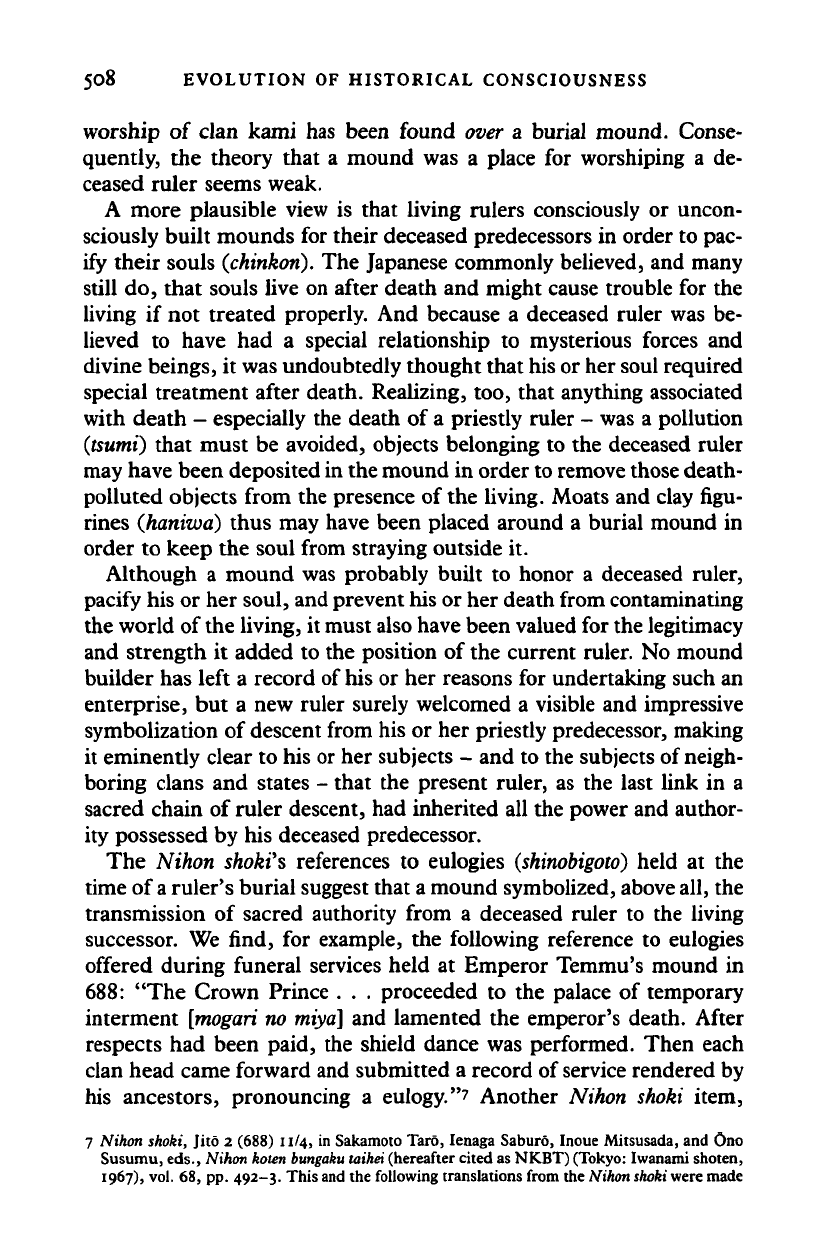
508 EVOLUTION OF HISTORICAL CONSCIOUSNESS
worship of clan kami has been found over a burial mound. Conse-
quently, the theory that a mound was a place for worshiping a de-
ceased ruler seems weak.
A more plausible view is that living rulers consciously or uncon-
sciously built mounds for their deceased predecessors in order to pac-
ify their souls
(chinkon).
The Japanese commonly believed, and many
still do, that souls live on after death and might cause trouble for the
living if not treated properly. And because a deceased ruler was be-
lieved to have had a special relationship to mysterious forces and
divine beings, it was undoubtedly thought that his or her soul required
special treatment after death. Realizing, too, that anything associated
with death - especially the death of a priestly ruler - was a pollution
(tsumi) that must be avoided, objects belonging to the deceased ruler
may have been deposited in the mound in order to remove those death-
polluted objects from the presence of the living. Moats and clay figu-
rines
Qianiwa)
thus may have been placed around a burial mound in
order to keep the soul from straying outside it.
Although a mound was probably built to honor a deceased ruler,
pacify his or her soul, and prevent his or her death from contaminating
the world of the living, it must also have been valued for the legitimacy
and strength it added to the position of the current ruler. No mound
builder has left a record of his or her reasons for undertaking such an
enterprise, but a new ruler surely welcomed a visible and impressive
symbolization of descent from his or her priestly predecessor, making
it eminently clear to his or her subjects - and to the subjects of neigh-
boring clans and states - that the present ruler, as the last link in a
sacred chain of ruler descent, had inherited all the power and author-
ity possessed by his deceased predecessor.
The Nihon shoki's references to eulogies
(shinobigoto)
held at the
time of
a
ruler's burial suggest that a mound symbolized, above
all,
the
transmission of sacred authority from a deceased ruler to the living
successor. We find, for example, the following reference to eulogies
offered during funeral services held at Emperor Temmu's mound in
688:
"The Crown Prince . . . proceeded to the palace of temporary
interment
[mogari
no
miya]
and lamented the emperor's death. After
respects had been paid, the shield dance was performed. Then each
clan head came forward and submitted a record of
service
rendered by
his ancestors, pronouncing a eulogy."
7
Another Nihon shoki item,
7 Nihon shoki, Jito 2 (688) 11/4, in Sakamoto Taro, lenaga Saburo, Inoue Mitsusada, and Ono
Susumu, eds., Nihon
koten bungaku taihei
(hereafter cited as NKBT) (Tokyo: Iwanami shoten,
I967)> vol. 68, pp. 492-3. This and the following translations from the Nihon
shoki
were made
Cambridge Histories Online © Cambridge University Press, 2008
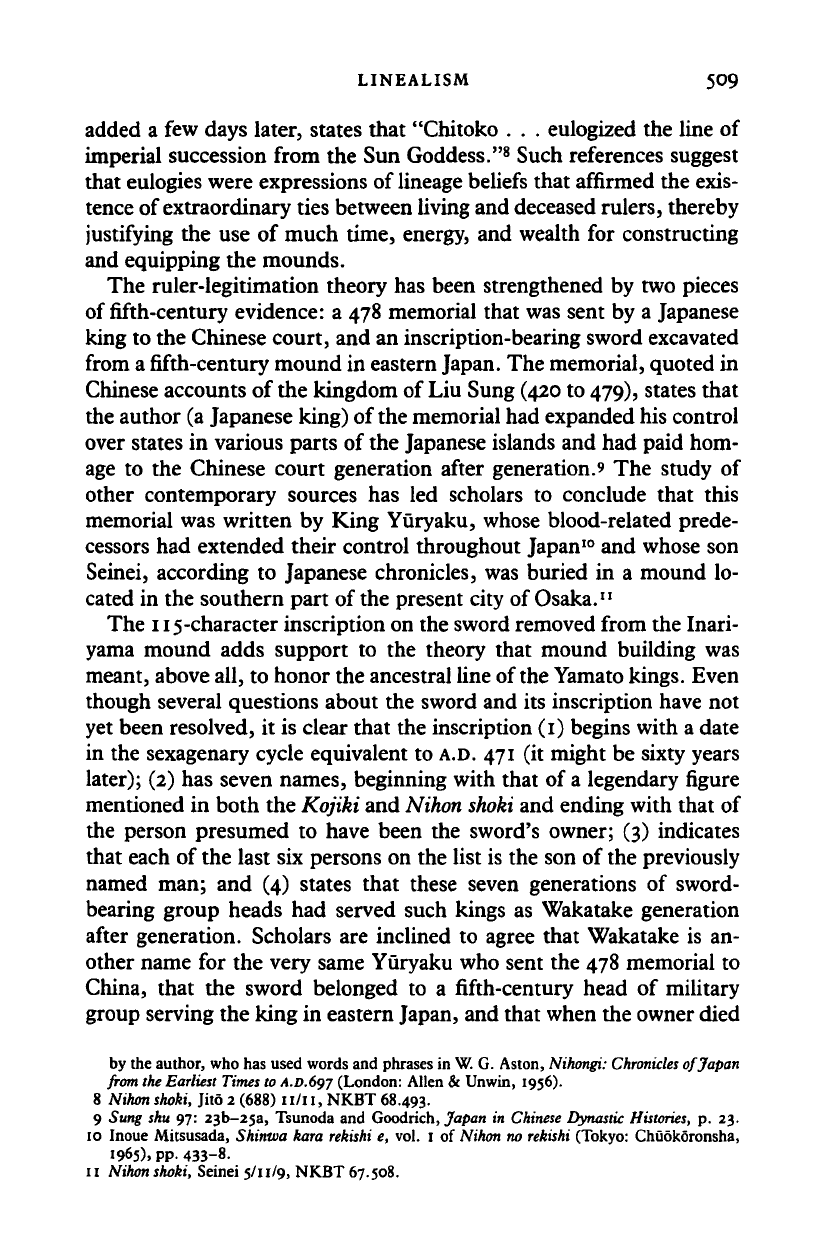
LINEALISM 509
added a few days later, states that "Chitoko . . . eulogized the line of
imperial succession from the Sun Goddess."
8
Such references suggest
that eulogies were expressions of lineage beliefs that affirmed the exis-
tence of extraordinary ties between living and deceased rulers, thereby
justifying the use of much time, energy, and wealth for constructing
and equipping the mounds.
The ruler-legitimation theory has been strengthened by two pieces
of fifth-century evidence: a 478 memorial that was sent by a Japanese
king to the Chinese court, and an inscription-bearing sword excavated
from a fifth-century mound in eastern Japan. The memorial, quoted in
Chinese accounts of the kingdom of Liu Sung (420 to 479), states that
the author (a Japanese king) of the memorial had expanded his control
over states in various parts of the Japanese islands and had paid hom-
age to the Chinese court generation after generation.* The study of
other contemporary sources has led scholars to conclude that this
memorial was written by King Yuryaku, whose blood-related prede-
cessors had extended their control throughout Japan
10
and whose son
Seinei, according to Japanese chronicles, was buried in a mound lo-
cated in the southern part of the present city of Osaka.
11
The 115-character inscription on the sword removed from the Inari-
yama mound adds support to the theory that mound building was
meant, above all, to honor the ancestral line of the Yamato
kings.
Even
though several questions about the sword and its inscription have not
yet been resolved, it is clear that the inscription (1) begins with a date
in the sexagenary cycle equivalent to
A.D.
471 (it might be sixty years
later);
(2) has seven names, beginning with that of a legendary figure
mentioned in both the Kojiki and Nihon
shoki
and ending with that of
the person presumed to have been the sword's owner; (3) indicates
that each of the last six persons on the list is the son of the previously
named man; and (4) states that these seven generations of sword-
bearing group heads had served such kings as Wakatake generation
after generation. Scholars are inclined to agree that Wakatake is an-
other name for the very same Yuryaku who sent the 478 memorial to
China, that the sword belonged to a fifth-century head of military
group serving the king in eastern Japan, and that when the owner died
by the author, who has used words and phrases in W. G. Aston, Nihongi:
Chronicles
of Japan
from the Earliest Times to A.D.697 (London: Allen & Unwin, 1956).
8 Nihon shoki, Jito 2 (688)
11/11,
NKBT 68.493.
9 Sung shu 97: 230-253, Tsunoda and Goodrich, Japan in Chinese Dynastic Histories, p. 23.
10 Inoue Mitsusada, Shinwa kara rekishi e, vol. 1 of Nihon no rekishi (Tokyo: Chuokdronsha,
1965).
PP- 433-8.
11 Nihon shoki, Seinei 5/11/9, NKBT 67.508.
Cambridge Histories Online © Cambridge University Press, 2008
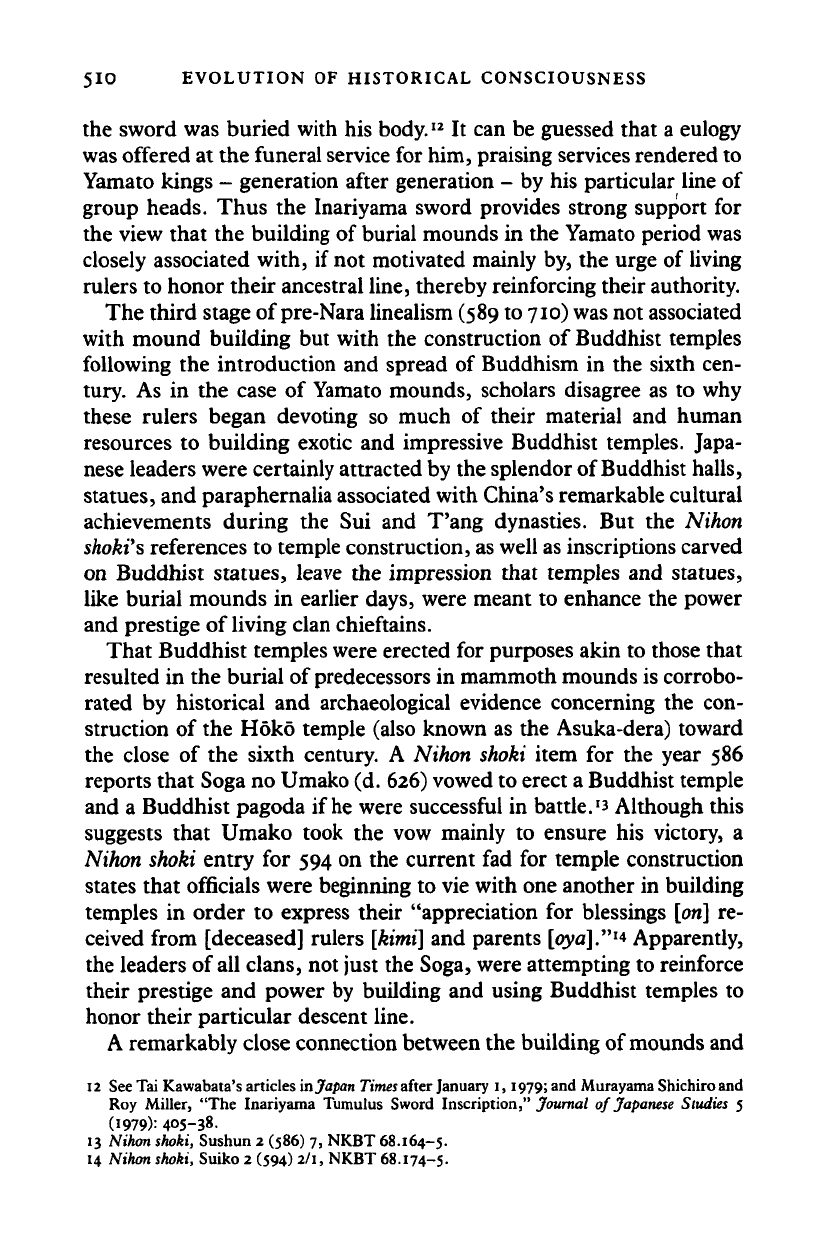
510 EVOLUTION OF HISTORICAL CONSCIOUSNESS
the sword was buried with his body.
12
It can be guessed that a eulogy
was offered at the funeral service for him, praising services rendered to
Yamato kings - generation after generation - by his particular line of
group heads. Thus the Inariyama sword provides strong support for
the view that the building of burial mounds in the Yamato period was
closely associated with, if not motivated mainly by, the urge of living
rulers to honor their ancestral line, thereby reinforcing their authority.
The third stage of pre-Nara linealism (589 to 710) was not associated
with mound building but with the construction of Buddhist temples
following the introduction and spread of Buddhism in the sixth cen-
tury. As in the case of Yamato mounds, scholars disagree as to why
these rulers began devoting so much of their material and human
resources to building exotic and impressive Buddhist temples. Japa-
nese leaders were certainly attracted by the splendor of Buddhist halls,
statues, and paraphernalia associated with China's remarkable cultural
achievements during the Sui and T'ang dynasties. But the Nihon
shoki's
references to temple construction, as well as inscriptions carved
on Buddhist statues, leave the impression that temples and statues,
like burial mounds in earlier days, were meant to enhance the power
and prestige of living clan chieftains.
That Buddhist temples were erected for purposes akin to those that
resulted in the burial of predecessors in mammoth mounds is corrobo-
rated by historical and archaeological evidence concerning the con-
struction of the Hoko temple (also known as the Asuka-dera) toward
the close of the sixth century. A Nihon shoki item for the year 586
reports that Soga no Umako (d. 626) vowed to erect a Buddhist temple
and a Buddhist pagoda if
he
were successful in battle.^ Although this
suggests that Umako took the vow mainly to ensure his victory, a
Nihon shoki entry for 594 on the current fad for temple construction
states that officials were beginning to vie with one another in building
temples in order to express their "appreciation for blessings
[on]
re-
ceived from [deceased] rulers
[kind]
and parents
[ova]."
1
*
Apparently,
the leaders of all clans, not just the Soga, were attempting to reinforce
their prestige and power by building and using Buddhist temples to
honor their particular descent line.
A remarkably close connection between the building of mounds and
12 See Tai Kawabata's articles in Japan
Times
after January 1,1979; and Murayama Shichiroand
Roy Miller, "The Inariyama Tumulus Sword Inscription," Journal of
Japanese
Studies 5
(1979):
405-38.
13 Nihon shoki, Sushun 2 (586) 7, NKBT 68.164-5.
14 Nihon shoki, Suiko 2 (594) 2/1, NKBT 68.174-5.
Cambridge Histories Online © Cambridge University Press, 2008
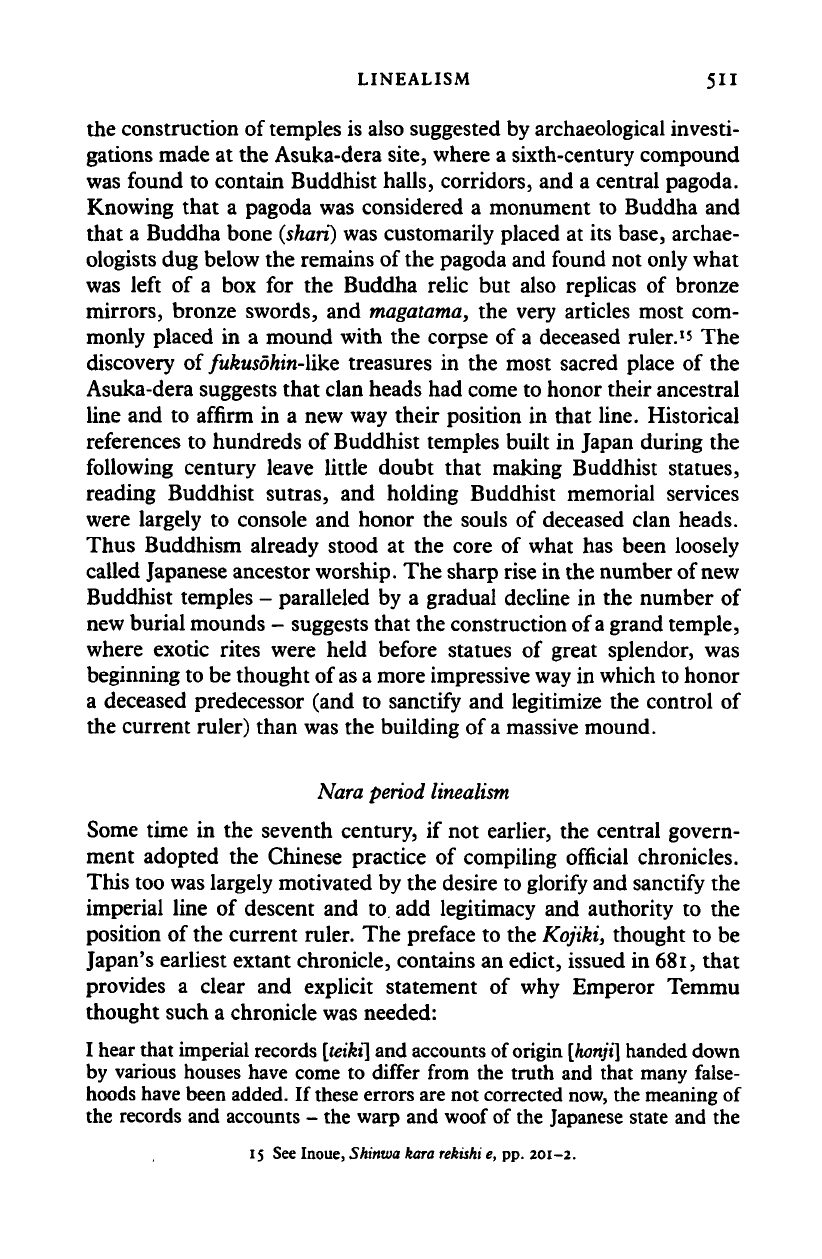
LINEALISM 511
the construction of temples is also suggested by archaeological investi-
gations made at the Asuka-dera site, where a sixth-century compound
was found to contain Buddhist halls, corridors, and a central pagoda.
Knowing that a pagoda was considered a monument to Buddha and
that a Buddha bone (shari) was customarily placed at its base, archae-
ologists dug below the remains of the pagoda and found not only what
was left of a box for the Buddha relic but also replicas of bronze
mirrors, bronze swords, and magatama, the very articles most com-
monly placed in a mound with the corpse of a deceased ruler.
15
The
discovery of fukusohin-likc treasures in the most sacred place of the
Asuka-dera suggests that clan heads had come to honor their ancestral
line and to affirm in a new way their position in that line. Historical
references to hundreds of Buddhist temples built in Japan during the
following century leave little doubt that making Buddhist statues,
reading Buddhist sutras, and holding Buddhist memorial services
were largely to console and honor the souls of deceased clan heads.
Thus Buddhism already stood at the core of what has been loosely
called Japanese ancestor worship. The sharp rise in the number of new
Buddhist temples - paralleled by a gradual decline in the number of
new burial mounds - suggests that the construction of a grand temple,
where exotic rites were held before statues of great splendor, was
beginning to be thought of
as
a more impressive way in which to honor
a deceased predecessor (and to sanctify and legitimize the control of
the current ruler) than was the building of a massive mound.
Nara period linealism
Some time in the seventh century, if not earlier, the central govern-
ment adopted the Chinese practice of compiling official chronicles.
This too was largely motivated by the desire to glorify and sanctify the
imperial line of descent and to. add legitimacy and authority to the
position of the current ruler. The preface to the Kojiki, thought to be
Japan's earliest extant chronicle, contains an edict, issued in 681, that
provides a clear and explicit statement of why Emperor Temmu
thought such a chronicle was needed:
I hear diat imperial records
[teiki]
and accounts of origin
[honji]
handed down
by various houses have come to differ from die truth and that many false-
hoods have been added. If
these
errors are not corrected now, the meaning of
the records and accounts - the warp and woof of the Japanese state and the
15 See Inoue, Shintva kara
rekishi
e, pp. 201-2.
Cambridge Histories Online © Cambridge University Press, 2008
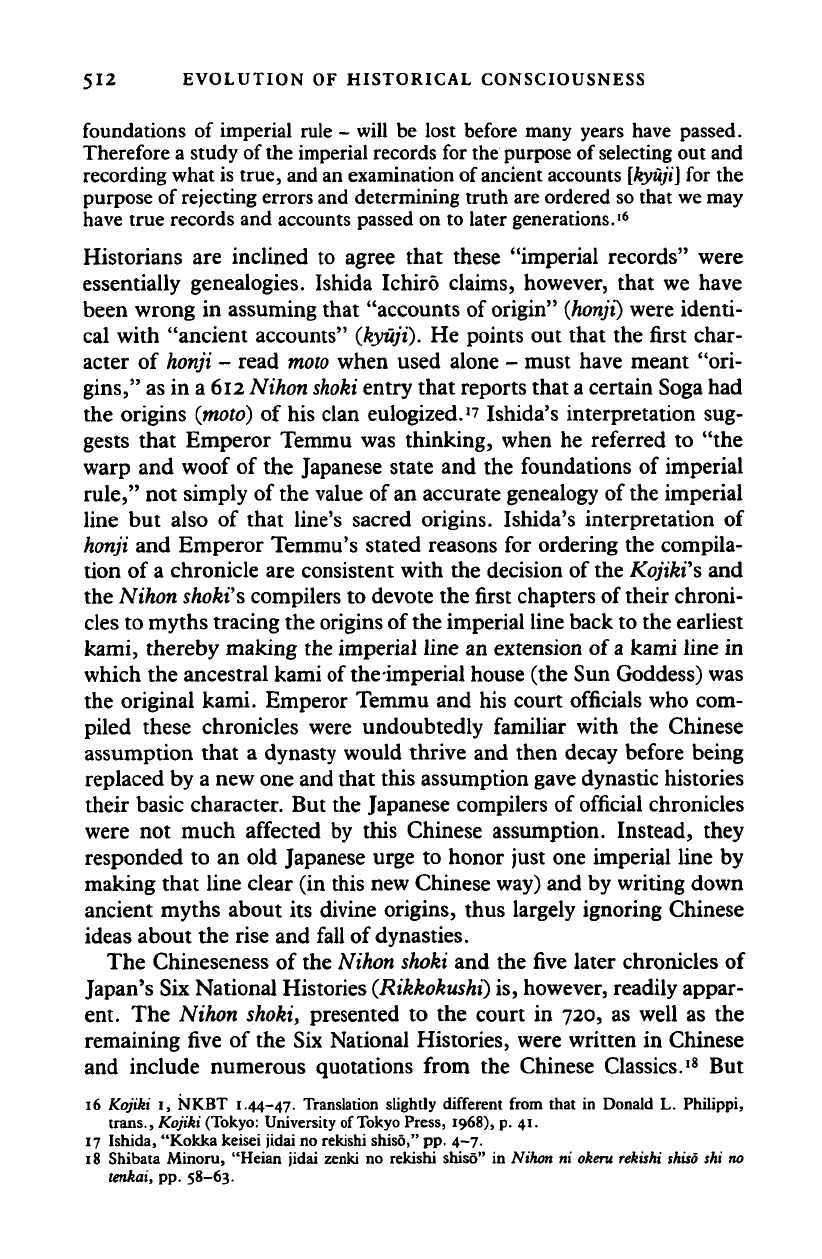
512 EVOLUTION OF HISTORICAL CONSCIOUSNESS
foundations of imperial rule - will be lost before many years have passed.
Therefore a study of the imperial records for the purpose of
selecting
out and
recording what is true, and an examination of ancient accounts
[kyuji]
for the
purpose of rejecting
errors and
determining truth are ordered so that
we
may
have true records and accounts passed on to later generations.
16
Historians are inclined to agree that these "imperial records" were
essentially genealogies. Ishida Ichiro claims, however, that we have
been wrong in assuming that "accounts of origin"
{honji)
were identi-
cal with "ancient accounts" (kyitji). He points out that the first char-
acter of
honji
- read
moto
when used alone - must have meant "ori-
gins,"
as in a 612 Nihon
shoki
entry that reports that a certain Soga had
the origins
(moto)
of his clan eulogized. •? Ishida's interpretation sug-
gests that Emperor Temmu was thinking, when he referred to "the
warp and woof of the Japanese state and the foundations of imperial
rule,"
not simply of the value of an accurate genealogy of the imperial
line but also of that line's sacred origins. Ishida's interpretation of
honji
and Emperor Temmu's stated reasons for ordering the compila-
tion of a chronicle are consistent with the decision of the Kojiki's and
the Nihon
shoki's
compilers to devote the first chapters of their chroni-
cles to myths tracing the origins of the imperial line back to the earliest
kami, thereby making the imperial line an extension of
a
kami line in
which the ancestral kami of the imperial house (the Sun Goddess) was
the original kami. Emperor Temmu and his court officials who com-
piled these chronicles were undoubtedly familiar with the Chinese
assumption that a dynasty would thrive and then decay before being
replaced by a new one and that this assumption gave dynastic histories
their basic character. But the Japanese compilers of official chronicles
were not much affected by this Chinese assumption. Instead, they
responded to an old Japanese urge to honor just one imperial line by
making that line clear (in this new Chinese way) and by writing down
ancient myths about its divine origins, thus largely ignoring Chinese
ideas about the rise and fall of dynasties.
The Chineseness of the Nihon
shoki
and the five later chronicles of
Japan's Six National Histories
(Rikkokushi)
is, however, readily appar-
ent. The Nihon shoki, presented to the court in 720, as well as the
remaining five of the Six National Histories, were written in Chinese
and include numerous quotations from the Chinese Classics.'
8
But
16 Kojiki I, NKBT 1.44-47. Translation slightly different from that in Donald L. Philippi,
trans.,
Kojiki (Tokyo: University of
Tokyo
Press, 1968), p. 41.
17 Ishida, "Kokka keisei jidai no rekishi shiso," pp. 4-7.
18 Shibata Minoru, "Heian jidai zenki no rekishi shiso" in Nihon ni
okeru rekishi shiso
shi no
tenkai,
pp.
58-63.
Cambridge Histories Online © Cambridge University Press, 2008
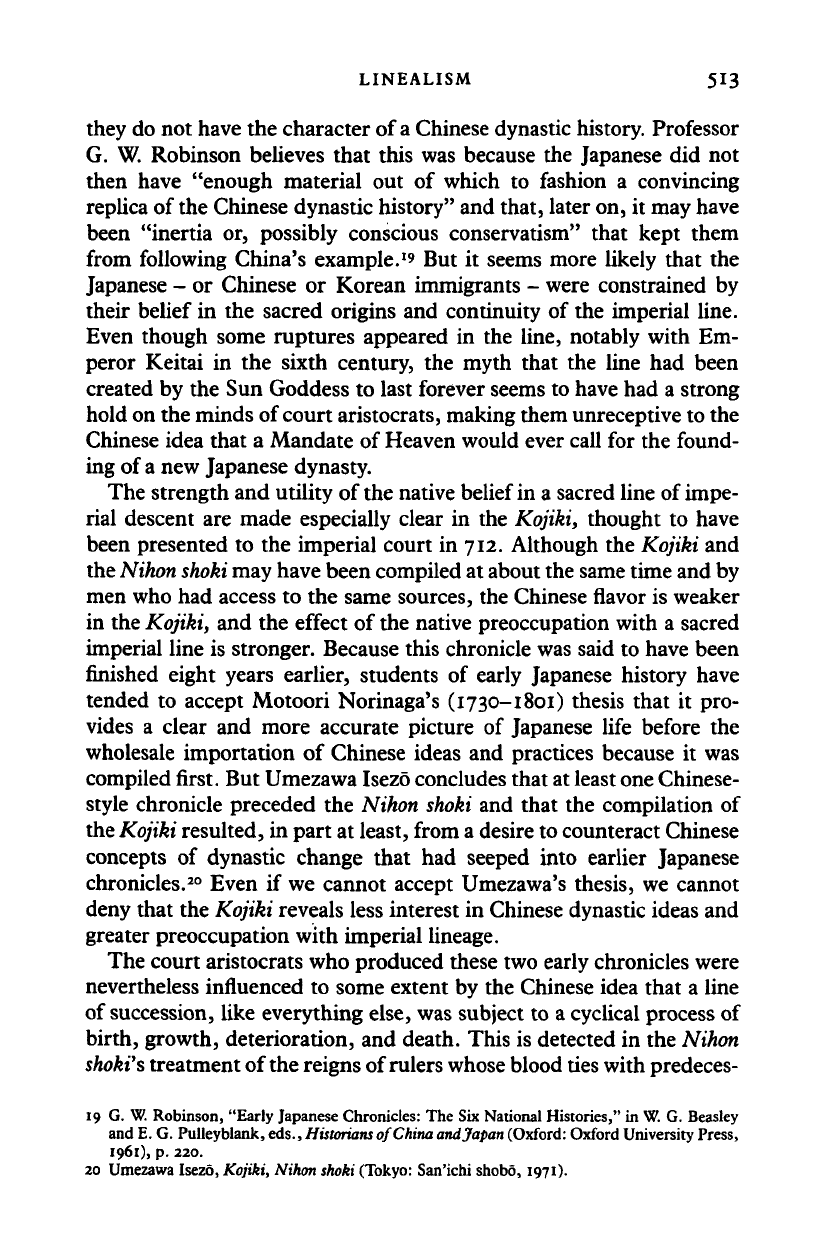
LINEALISM 513
they do not have the character of
a
Chinese dynastic history. Professor
G. W. Robinson believes that this was because the Japanese did not
then have "enough material out of which to fashion a convincing
replica of the Chinese dynastic history" and that, later on, it may have
been "inertia or, possibly conscious conservatism" that kept them
from following China's example.
19
But it seems more likely that the
Japanese - or Chinese or Korean immigrants - were constrained by
their belief in the sacred origins and continuity of the imperial line.
Even though some ruptures appeared in the line, notably with Em-
peror Keitai in the sixth century, the myth that the line had been
created by the Sun Goddess to last forever seems to have had a strong
hold on the minds of court aristocrats, making them unreceptive to the
Chinese idea that a Mandate of Heaven would ever call for the found-
ing of
a
new Japanese dynasty.
The strength and utility of the native belief in a sacred line of impe-
rial descent are made especially clear in the Kojiki, thought to have
been presented to the imperial court in 712. Although the Kojiki and
the
Nihon shoki
may have been compiled at about the same time and by
men who had access to the same sources, the Chinese flavor is weaker
in the Kojiki, and the effect of the native preoccupation with a sacred
imperial line is stronger. Because this chronicle was said to have been
finished eight years earlier, students of early Japanese history have
tended to accept Motoori Norinaga's (1730-1801) thesis that it pro-
vides a clear and more accurate picture of Japanese life before the
wholesale importation of Chinese ideas and practices because it was
compiled first. But Umezawa Isezo concludes that at least one Chinese-
style chronicle preceded the Nihon
shoki
and that the compilation of
the Kojiki resulted, in part at least, from a desire to counteract Chinese
concepts of dynastic change that had seeped into earlier Japanese
chronicles.
20
Even if we cannot accept Umezawa's thesis, we cannot
deny that the Kojiki reveals less interest in Chinese dynastic ideas and
greater preoccupation with imperial lineage.
The court aristocrats who produced these two early chronicles were
nevertheless influenced to some extent by the Chinese idea that a line
of succession, like everything else, was subject to a cyclical process of
birth, growth, deterioration, and death. This is detected in the Nihon
shoki's
treatment of the reigns of rulers whose blood ties with predeces-
19 G. W. Robinson, "Early Japanese Chronicles: The Six National Histories," in W. G. Beasley
and E. G. Pulley blank, eds., Historians of China and Japan (Oxford: Oxford University Press,
1961),
p. 220.
20 Umezawa Isezo, Kojiki, Nihon shoki (Tokyo: San'ichi shobo, 1971).
Cambridge Histories Online © Cambridge University Press, 2008
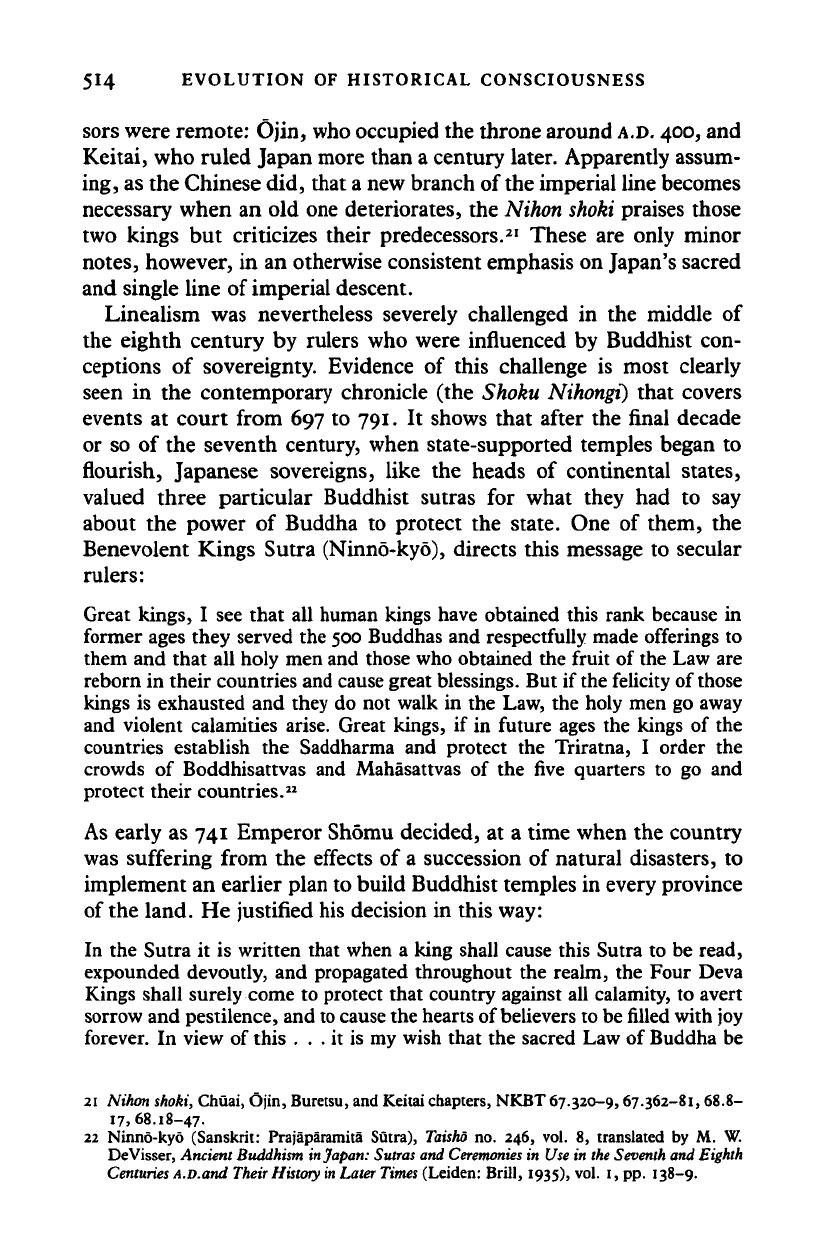
514 EVOLUTION OF HISTORICAL CONSCIOUSNESS
sors were remote: Ojin, who occupied the throne around
A.D.
400, and
Keitai, who ruled Japan more than a century later. Apparently assum-
ing, as the Chinese did, that
a
new branch of the imperial line becomes
necessary when an old one deteriorates, the Nihon
shoki
praises those
two kings but criticizes their predecessors.
21
These are only minor
notes,
however, in an otherwise consistent emphasis on Japan's sacred
and single line of imperial descent.
Linealism was nevertheless severely challenged in the middle of
the eighth century by rulers who were influenced by Buddhist con-
ceptions of sovereignty. Evidence of this challenge is most clearly
seen in the contemporary chronicle (the Shoku Nihongt) that covers
events at court from 697 to 791. It shows that after the final decade
or so of the seventh century, when state-supported temples began to
flourish, Japanese sovereigns, like the heads of continental states,
valued three particular Buddhist sutras for what they had to say
about the power of Buddha to protect the state. One of them, the
Benevolent Kings Sutra (Ninno-kyo), directs this message to secular
rulers:
Great kings, I see that all human kings have obtained this rank because in
former ages they served the 500 Buddhas and respectfully made offerings to
them and that all holy men and those who obtained the fruit of the Law are
reborn in their countries and cause great blessings. But if the felicity of those
kings is exhausted and they do not walk in the Law, the holy men go away
and violent calamities arise. Great kings, if in future ages the kings of the
countries establish the Saddharma and protect the Triratna, I order the
crowds of Boddhisattvas and Mahasattvas of the five quarters to go and
protect their countries."
As early as 741 Emperor Shomu decided, at a time when the country
was suffering from the effects of a succession of natural disasters, to
implement an earlier plan to build Buddhist temples in every province
of the land. He justified his decision in this way:
In the Sutra it is written that when a king shall cause this Sutra to be read,
expounded devoutly, and propagated throughout the realm, the Four Deva
Kings shall surely come to protect that country against all calamity, to avert
sorrow and pestilence, and to cause the hearts of believers to be
filled
with joy
forever. In view of this ... it is my wish that the sacred Law of Buddha be
21 Nihon shoki, Chuai, Ojin, Buretsu, and Keitai chapters, NKBT 67.320-9,67.362-81,68.8-
17,68.18-47.
22 Ninno-kyo (Sanskrit: Prajaparamita Sutra), Taisho no. 246, vol. 8, translated by M. W.
DeVisser, Ancient Buddhism in Japan: Sutras and
Ceremonies
in Use in
the
Seventh and Eighth
Centuries
A.D.and
Their
History
in
Later
Times
(Leiden: Brill, 1935), vol. 1, pp. 138-9.
Cambridge Histories Online © Cambridge University Press, 2008
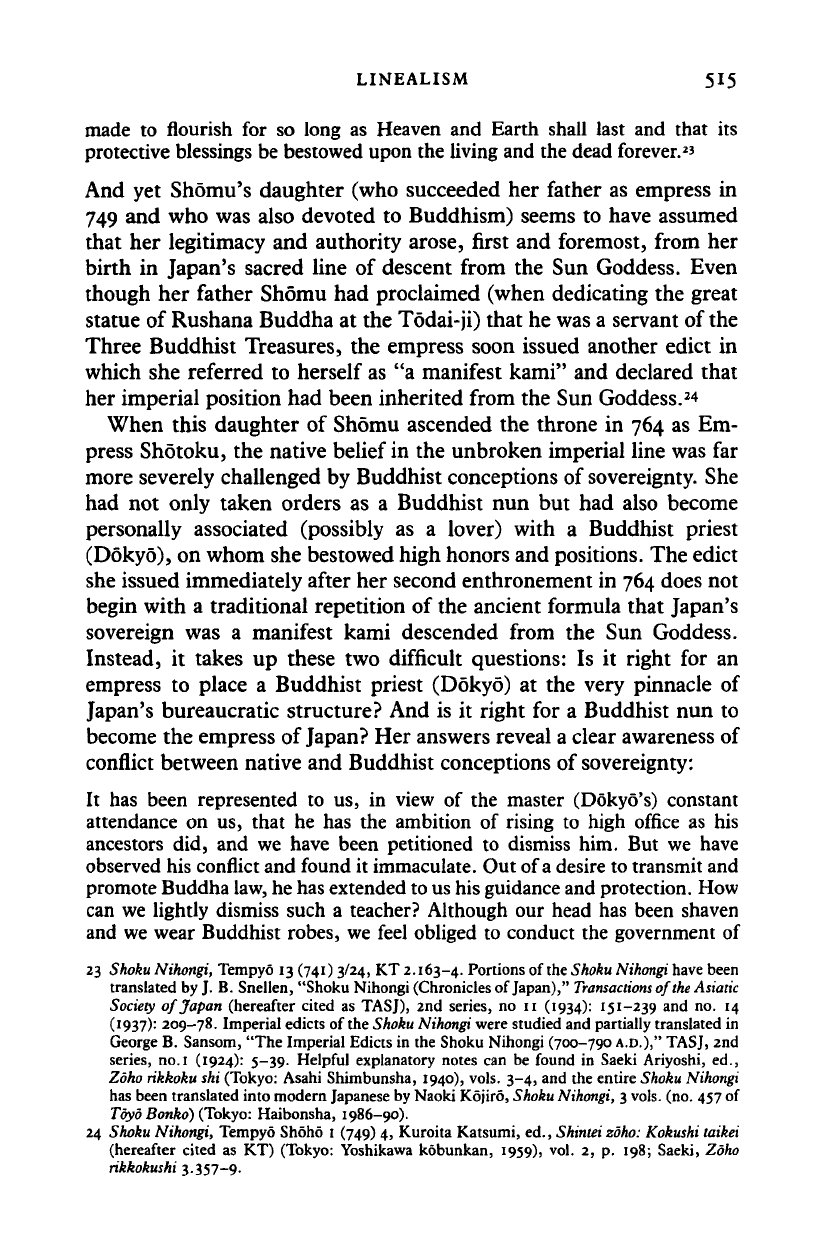
LINEALISM 515
made to flourish for so long as Heaven and Earth shall last and that its
protective blessings be bestowed upon the living and the dead forever."
And yet Shomu's daughter (who succeeded her father as empress in
749 and who was also devoted to Buddhism) seems to have assumed
that her legitimacy and authority arose, first and foremost, from her
birth in Japan's sacred line of descent from the Sun Goddess. Even
though her father Shomu had proclaimed (when dedicating the great
statue of Rushana Buddha at the Todai-ji) that he was a servant of the
Three Buddhist Treasures, the empress soon issued another edict in
which she referred to herself as "a manifest kami" and declared that
her imperial position had been inherited from the Sun Goddess.
24
When this daughter of Shomu ascended the throne in 764 as Em-
press Shotoku, the native belief in the unbroken imperial line was far
more severely challenged by Buddhist conceptions of
sovereignty.
She
had not only taken orders as a Buddhist nun but had also become
personally associated (possibly as a lover) with a Buddhist priest
(Dokyo), on whom she bestowed high honors and positions. The edict
she issued immediately after her second enthronement in 764 does not
begin with a traditional repetition of the ancient formula that Japan's
sovereign was a manifest kami descended from the Sun Goddess.
Instead, it takes up these two difficult questions: Is it right for an
empress to place a Buddhist priest (Dokyo) at the very pinnacle of
Japan's bureaucratic structure? And is it right for a Buddhist nun to
become the empress of
Japan?
Her answers reveal a clear awareness of
conflict between native and Buddhist conceptions of sovereignty:
It has been represented to us, in view of the master (Dokyo's) constant
attendance on us, that he has the ambition of rising to high office as his
ancestors did, and we have been petitioned to dismiss him. But we have
observed his conflict and found it immaculate. Out of a desire to transmit and
promote Buddha law, he has extended to us his guidance and protection. How
can we lightly dismiss such a teacher? Although our head has been shaven
and we wear Buddhist robes, we feel obliged to conduct the government of
23 Shoku Nihongi, Tempyo 13 (741) 3/24, KT 2.163-4. Portions of the Shoku Nihongi have been
translated by J. B. Snellen, "Shoku Nihongi (Chronicles of
Japan),"
Transactions
of
the
Asiatic
Society of Japan (hereafter cited as TASJ), 2nd series, no 11 (1934): 151-239 and no. 14
(1937):
209-78. Imperial edicts of the Shoku Nihongi were studied and partially translated in
George B. Sansom, "The Imperial Edicts in the Shoku Nihongi (700-790
A.D.),"
TASJ, 2nd
series,
no.i (1924): 5-39. Helpful explanatory notes can be found in Saeki Ariyoshi, ed.,
Zoho rikkoku shi (Tokyo: Asahi Shimbunsha, 1940), vols. 3-4, and the entire Shoku Nihongi
has been translated into modern Japanese by Naoki Kojiro, Shoku Nihongi, 3 vols. (no. 457 of
ToyoBonko) (Tokyo: Haibonsha, 1986-90).
24 Shoku Nihongi, Tempyo Shoho I (749) 4, Kuroita Katsumi, ed., Shintei zoho: Kokushi taikei
(hereafter cited as KT) (Tokyo: Yoshikawa kobunkan, 1959), vol. 2, p. 198; Saeki, Zoho
rikkokushi 3.357-9.
Cambridge Histories Online © Cambridge University Press, 2008
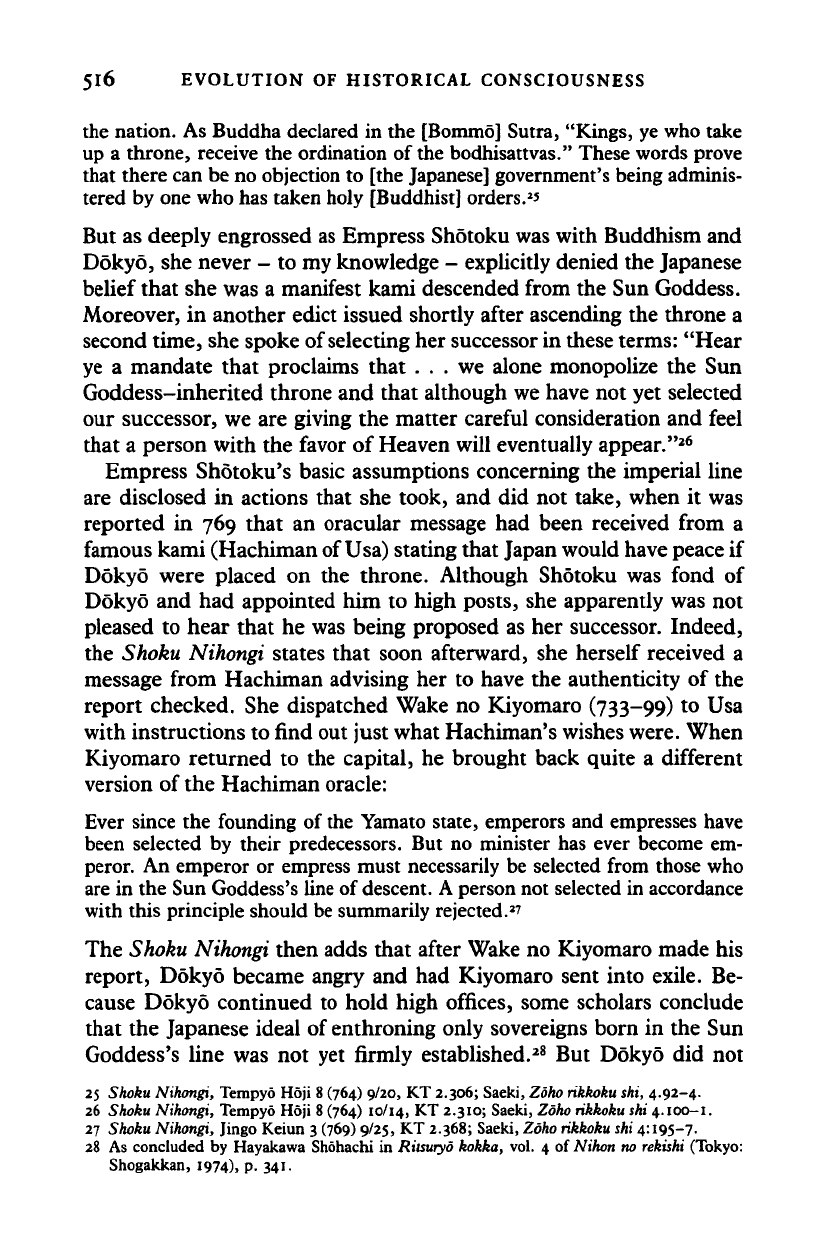
5l6 EVOLUTION OF HISTORICAL CONSCIOUSNESS
the nation. As Buddha declared in the [Bommo] Sutra, "Kings, ye who take
up a throne, receive the ordination of the bodhisattvas." These words prove
that there can be no objection to [the Japanese] government's being adminis-
tered by one who has taken holy [Buddhist] orders.
2
'
But as deeply engrossed as Empress Shotoku was with Buddhism and
Dokyo, she never - to my knowledge - explicitly denied the Japanese
belief that she was a manifest kami descended from the Sun Goddess.
Moreover, in another edict issued shortly after ascending the throne a
second time, she spoke of selecting her successor in these terms: "Hear
ye a mandate that proclaims that ... we alone monopolize the Sun
Goddess-inherited throne and that although we have not yet selected
our successor, we are giving the matter careful consideration and feel
that a person with the favor of Heaven will eventually appear."
26
Empress Shotoku's basic assumptions concerning the imperial line
are disclosed in actions that she took, and did not take, when it was
reported in 769 that an oracular message had been received from a
famous kami (Hachiman of Usa) stating that Japan would have peace if
Dokyo were placed on the throne. Although Shotoku was fond of
Dokyo and had appointed him to high posts, she apparently was not
pleased to hear that he was being proposed as her successor. Indeed,
the Shoku Nihongi states that soon afterward, she herself received a
message from Hachiman advising her to have the authenticity of the
report checked. She dispatched Wake no Kiyomaro (733-99) to Usa
with instructions to find out just what Hachiman's wishes were. When
Kiyomaro returned to the capital, he brought back quite a different
version of the Hachiman oracle:
Ever since the founding of the Yamato state, emperors and empresses have
been selected by their predecessors. But no minister has ever become em-
peror. An emperor or empress must necessarily be selected from those who
are in the Sun Goddess's line of descent. A person not selected in accordance
with this principle should be summarily rejected.
2
'
The Shoku Nihongi then adds that after Wake no Kiyomaro made his
report, Dokyo became angry and had Kiyomaro sent into exile. Be-
cause Dokyo continued to hold high offices, some scholars conclude
that the Japanese ideal of enthroning only sovereigns born in the Sun
Goddess's line was not yet firmly established.
28
But Dokyo did not
25 Shoku Nihongi, Tempyo Hoji 8 (764) 9/20, KT 2.306; Saeki, Zoho rikkoku shi, 4.92-4.
26 Shoku Nihongi, Tempyo Hoji 8 (764) 10/14, KT 2.310; Saeki, Zoho rikkoku shi 4.100-1.
27 Shoku Nihongi, Jingo Keiun 3 (769) 9/25, KT 2.368; Saeki, Zoho rikkoku shi 4:195-7.
28 As concluded by Hayakawa Shohachi in Riisuryo kokka, vol. 4 of Nihon no rekishi (Tokyo:
Shogakkan, 1974). P- 341-
Cambridge Histories Online © Cambridge University Press, 2008
